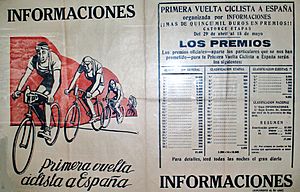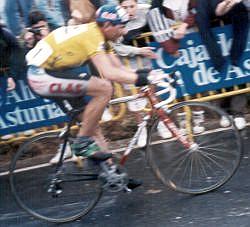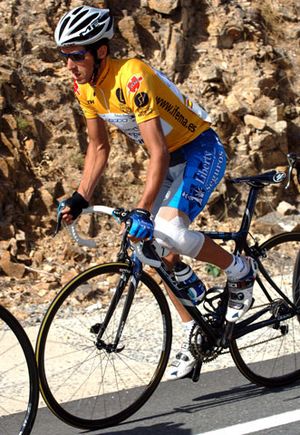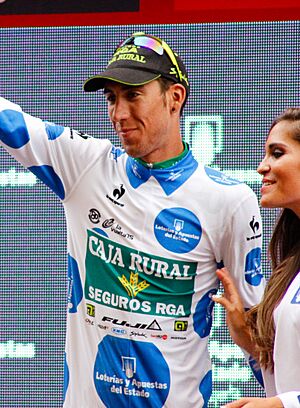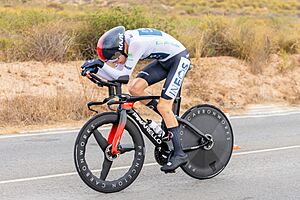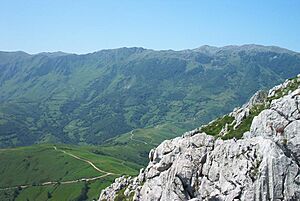Vuelta a España facts for kids
 |
|
| Race details | |
|---|---|
| Date | August–September (since 1995) |
| Region | Spain |
| English name | Tour of Spain |
| Local name(s) | Vuelta Ciclista a España |
| Nickname(s) | La Vuelta |
| Discipline | Road |
| Competition | UCI World Tour |
| Type | Grand Tour |
| Organiser | Unipublic Amaury Sport Organisation |
| Race director | Javier Guillén |
| History | |
| First edition | 29 April 1935 |
| Editions | 79 (as of 2024) |
| First winner | |
| Most wins | (4 wins) |
| Most recent | |
The Vuelta a España (which means "Tour of Spain" in English) is a big annual bike race. It takes place mostly in Spain, but sometimes goes through nearby countries too. This exciting race was first held in 1935. It was inspired by other famous races like the Tour de France and the Giro d'Italia.
In its early years, the race had to stop because of the Spanish Civil War and World War II. However, since 1955, the Vuelta has happened every year. As it became more popular, the race got longer and included riders from all over the world.
The Vuelta is part of the UCI World Tour. This means that most of the teams competing are top-level professional teams. The organizers can also invite a few special "wild card" teams. Along with the Tour de France and Giro d'Italia, the Vuelta is one of cycling's three most important races, known as Grand Tours.
The Vuelta lasts for three weeks. Its route changes each year, but it always includes at least two time trials. Riders also face tough mountain climbs, often in the Pyrenees or Cantabrian Mountains. The race usually finishes in Spain's capital city, Madrid. Modern Vueltas have 21 daily stages over 23 days, with two rest days.
The race used to be held in spring, but in 1995, it moved to September. This change helped it avoid clashing with the Giro d'Italia. Now, the Vuelta is often a key race for riders preparing for the UCI Road World Championships. The 2020 race was held later, in October, because of the COVID-19 pandemic.
All stages are timed. The rider with the lowest total time is the race leader. They get to wear the special red jersey. Besides the overall leader, there are other important competitions. These include the points classification for sprinters, the mountains classification for climbers, and the team classification for the best team. There used to be a "combination classification" for all-around riders, but that ended in 2018.
A women's version of the race, La Vuelta Femenina, started in 2023. It's part of the UCI Women's World Tour. Before this, smaller women's races were held alongside the Vuelta from 2015 to 2022.
Contents
History of the Vuelta
How the Race Started
The first bike races in Spain were national events. They were promoted by bike makers from Eibar. One early race was called the Grand Prix of the Republic.

In early 1935, a former cyclist named Clemente López Doriga worked with Juan Pujol. Pujol was the director of a newspaper called Informaciones. They decided to organize the Vuelta a España. The idea was to boost the newspaper's sales, just like the Tour de France helped L'Auto and the Giro d'Italia helped La Gazzetta dello Sport.
The first Vuelta had 50 riders. They covered 3,411 km (2,119 miles) in just 14 stages. Each stage was very long, averaging over 240 km (149 miles). The first stage went from Madrid to Valladolid. The first big rivalry was between Gustaaf Deloor from Belgium, who won, and Mariano Cañardo from Spain.
The second Vuelta happened in 1936, even though the political situation was tricky. Gustaaf Deloor won again, leading from start to finish. This 1936 race was the longest Vuelta ever, at 4,407 km (2,738 miles) over 22 stages. Gustaaf's older brother, Alfons, finished second.
After these two races, the Vuelta stopped because of the Spanish Civil War.
The Vuelta Returns: 1940s and 1950s
The Vuelta started again in 1941. Most of the riders were Spanish, with few from other countries. This year also saw the first time trial in the Vuelta. Julián Berrendero won that year and again in 1942. He also won the King of the Mountains title three years in a row.
The race stopped again because of World War II and money problems.
In 1945, a newspaper called Journal took over organizing the race. It started again, but still with few international riders. Delio Rodríguez won the overall race. This year also introduced the points classification, but it wasn't a regular part of the race until 1955. Four Vueltas were held until 1950.
Then, there was another break until 1955. The Basque newspaper El Correo Español-El Pueblo Vasco became the new organizer. Since then, the Vuelta a España has been held every year. It now usually takes place in August and September. In the past, it was in April and May. More riders, including famous international ones, started to join the race.
Growing Popularity: 1960s and 1970s
The Vuelta became more famous, attracting top international cyclists. In the late 1950s, Italian and French riders started winning. In the 1960s, German and Dutch riders also found success. In 1963, Jacques Anquetil won, becoming the first rider to win all three Grand Tours (Tour de France, Giro d'Italia, and Vuelta a España). Later, other cycling legends like Felice Gimondi (1968), Eddy Merckx (1973), Bernard Hinault (1978, 1983), Alberto Contador (2008), Vincenzo Nibali (2010), and Chris Froome (2017) also achieved this amazing feat.
Antonio Karmany was a strong climber, winning the mountains classification three years in a row. Then, Julio Jiménez took over, winning it for another three years.
In 1965, Rik Van Looy was the first to win the points classification twice. Jan Janssen (1968) and Domingo Perurena (1974) also won it twice.
The organizers faced some money problems in the mid-1960s, but the races still happened. In 1968, a stage had to be canceled due to an incident, but no one was hurt.
The 1970s started with a win by Luis Ocaña, a big name in cycling. José Manuel Fuente won twice, in 1972 and 1974. Bernard Hinault and Pedro Delgado also won the race twice later on.
In 1973, Eddy Merckx dominated the Vuelta, winning six stages and almost all the individual awards. Freddy Maertens had a similar strong performance in 1977, winning thirteen stages and most of the awards.
In the mid-1970s, Andrés Oliva won the King of the Mountains title three times.
French star Bernard Hinault won in 1978. The last stage of that race was stopped because of protests. In 1979, the newspaper El Correo Español-El Pueblo Vasco stopped sponsoring the race. A company called Unipublic took over. With more advertising and TV broadcasts, the Vuelta became even more popular.
New Eras: 1980s and 1990s
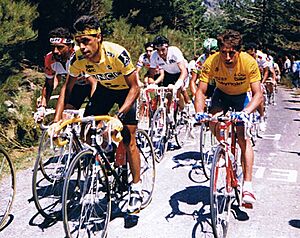
In the early 1980s, José Luis Laguía won the mountain classification five times. Sean Kelly won the points classification four times.
In 1982, the winner, Ángel Arroyo, was disqualified for a rule violation. His victory went to Marino Lejarreta. Arroyo appealed, but the test results were confirmed.
The Lagos de Covadonga climb was first used as a stage finish in 1983. It became one of the most famous climbs in the Vuelta. In 1984, the race had the closest finish ever. Éric Caritoux, a lesser-known rider, won by only six seconds over Alberto Fernández.
The late 1980s saw Colombian cyclists, like Lucho Herrera (who won in 1987) and Fabio Parra, become very strong in the mountains. Pedro Delgado was also a top rider, winning twice (1985 and 1989). The 1988 race started in the Canary Islands. Irish rider Sean Kelly won that year, his only Grand Tour victory.
The first half of the 1990s was dominated by Swiss rider Tony Rominger. He was the first to win the race three times in a row, from 1992 to 1994.
The 50th Vuelta, in 1995, was when the race moved to September. This change aimed to attract more top riders who might have chosen the Giro or Tour de France before. That year, Laurent Jalabert won all the main classifications. He also matched Sean Kelly's record of four points classification wins.
In 1997, the Vuelta started outside Spain for the first time, in Lisbon, Portugal.
The tough Alto de L'Angliru climb was first included in 1999. José María Jiménez won that stage. This climb quickly became famous for being incredibly steep.
21st Century Victories: 2000s to Present
The early 2000s were marked by Roberto Heras's success. He won the Vuelta three times, and then a fourth time in 2005. However, he was later disqualified from his 2005 win due to a rule violation. The win was given to Denis Menchov. In 2012, a Spanish court changed the decision, giving the 2005 win back to Heras.
In 2006, Alexander Vinokourov won. In 2007, Denis Menchov won the overall race again. In 2008, the company that organizes the Tour de France, Amaury Sport Organisation (ASO), bought part of Unipublic.
In 2008, Spanish rider Alberto Contador won. He also won the Giro d'Italia that year. This made him the first Spaniard to win all three Grand Tours. In 2009, the Vuelta started in the Netherlands, then went through Belgium and Germany. Alejandro Valverde won that year.
Vincenzo Nibali won the 2010 race. He didn't win any stages but consistently finished well. This was his first Grand Tour victory.
The 2011 race was the first in 33 years to visit the Basque Country. Juan José Cobo was originally declared the winner, just 13 seconds ahead of Chris Froome. Both riders were supporting their team leaders at the start. In 2019, Cobo's win was canceled due to rule violations, and the victory was given to Froome.
In 2012, Alberto Contador won for the second time. He won a stage with a solo attack and finished 1 minute and 16 seconds ahead of Alejandro Valverde. Joaquim Rodríguez finished third.
The 2013 Vuelta a España had a surprising winner: 41-year-old American Chris Horner. He became the first North American to win the Vuelta and the oldest rider to win a Grand Tour.
In March 2014, ASO took full control of Unipublic, and they now work together to run the race.
The 2014 race had many strong riders. Alberto Contador won his third Vuelta, even after crashing out of the Tour de France earlier that year. He took the red jersey on stage 10 and won two mountain stages. Chris Froome finished second, and Alejandro Valverde was third.
The 2015 race also had a strong field. Riders like Esteban Chaves and Tom Dumoulin took turns leading the race. After some top riders left the race, Fabio Aru took the lead on a tough mountain stage. He held it for five stages but lost it to Joaquim Rodríguez. Dumoulin regained the lead in a time trial, but Aru attacked on the second-to-last day and won his first Grand Tour.
Nairo Quintana won the 2016 edition, with Froome in second place. Quintana gained a lot of time on Froome in a mountain stage. Even though Froome fought back, Quintana held on to win by 1 minute and 23 seconds. He became the second Colombian to win the Vuelta.
The 2017 race started in Nîmes, France. Chris Froome, who had also won the 2017 Tour de France that year, won the Vuelta. He became the third rider to win both the Tour and Vuelta in the same year. Froome also won the points and combination classifications.
In 2018, another British rider, Simon Yates, won the race. This was his first Grand Tour win. It also meant that for the first time, all three Grand Tours in one year were won by riders from the same country.

The 2019 Vuelta was won by Primož Roglič, who was the first Slovenian cyclist to win a Grand Tour.
The 2020 Vuelta a España was delayed due to the COVID-19 pandemic. It was shorter than usual, with 18 stages instead of 21. Roglič defended his title in a very close race against Richard Carapaz, winning by only 24 seconds. This was one of the closest Vueltas ever.
In 2021, Roglič returned and won the 2021 Vuelta a España for his third time in a row. He became only the third rider to achieve three consecutive wins. He won by a large margin of 4 minutes and 42 seconds.
The 2022 Vuelta a España was won by Belgian Remco Evenepoel. It started in Utrecht, Netherlands.
The 2023 Vuelta a España was won by Sepp Kuss. He took the red jersey early and held onto it, winning by 17 seconds over his teammate Jonas Vingegaard. Primož Roglič, also on the same team, finished third. This was the first time one team had all three top spots in a Grand Tour.
The 2024 Vuelta a España was won by Primož Roglič, who tied Roberto Heras's record for the most overall wins.
Race Classifications and Jerseys
The leader of the Vuelta wears a red jersey. This is like the yellow jersey in the Tour de France. Other special jerseys are given to the best climber (the "King of the Mountains," who wears a blue-on-white polka dot jersey) and the leader of the points competition (who wears a green jersey).
Since 1950, leaders of different classifications have worn special jerseys. For a long time, the points leader wore a blue jersey, the mountains leader wore green, and the combination leader wore white. Recently, the jerseys have changed to be more like those in the Tour de France. The points leader now wears green, the King of the Mountains wears a blue-on-white polka dot jersey, and the best young rider wears a white jersey.
General Classification: The Red Jersey
The rider with the lowest total time in the race is the leader of the general classification. They get to wear a special jersey, called the maillot rojo or red jersey.
The color of the leader's jersey has changed many times over the years. It started as orange in 1935, then white in 1941, and back to orange in 1942. From 1945 to 1950, it was white with a red stripe.
In 1955, when the race started again, the jersey became yellow, just like the Tour de France. Except for 1977, the yellow jersey was used until 1998, when it changed to a deeper gold color.
However, for the 2010 race, the leader's jersey was changed to red, which it remains today.
The record for most overall wins is held by Roberto Heras and Primož Roglič, both with four victories. Spanish riders have won the Vuelta 32 times. Riders from France, Belgium, Switzerland, Italy, Germany, the Netherlands, Colombia, Ireland, Russia, Kazakhstan, the United States, and Great Britain have also won.
Mountains Classification: The Polka Dot Jersey
The mountains classification rewards the best climbers. Points are given to riders who cross mountain tops first. This classification started in 1935. Until 2005, the leader wore a green jersey. In 2006, it became orange, and since 2010, it has been white with blue dots.
Spanish rider José Luis Laguía has won this classification a record five times. Other Spanish cyclists like Antonio Karmany, Julio Jiménez, and José María Jiménez have won it three times in a row. Overall, Spanish riders have won this classification 47 out of 68 times. In 2011, David Moncoutié became the first rider to win this award four years in a row.
The mountains jersey is the third most important jersey. If a rider leads both the overall race and the mountains classification, they wear the red jersey. The mountains jersey then goes to the second-place rider in that classification.
The Vuelta organizers decide which climbs give points and how many. The toughest climbs give the most points. If riders have the same points, the one who performed better on the hardest climbs gets a higher ranking.
Points Classification: The Green Jersey
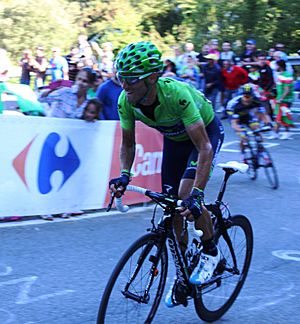
The points classification rewards riders who finish well in stages, especially sprinters. Points are given based on a rider's finishing position in each stage.
This classification was first used in 1945. The winner of a stage got 100 points, second place 99, and so on. Points were also given for time gaps and mountain points. However, it wasn't used again until 1955.
In 1955, the system changed to adding up stage ranks, similar to the Tour de France. The leader, with the fewest points, wore a green jersey. In 1963, the system changed again. Now, points are given to the first riders to finish, and the rider with the most points is the leader.
Seán Kelly, Laurent Jalabert, and Alejandro Valverde share the record for most wins, with four titles each.
Young Rider Classification: The White Jersey
The young rider classification is for the best young cyclist in the race. It's based on their total time, just like the overall general classification. The winner wears a white jersey.
From 2017 to 2018, the young rider winner only wore a red number bib. This was because the white jersey was used for the combination classification.
Team Classification
The team classification has been awarded since the very first race in 1935. It recognizes the best overall team performance.
Old Classifications
The combination classification used to combine a rider's rankings in the general, points, and mountains classifications. The rider with the lowest total score won. This award often went to the top riders in the race. It was stopped in 2019. Now, the white jersey is used for the best young rider.
The Race Route and Stages
The Vuelta course usually includes up to three time trials and several mountain stages. Since 1994, the race has often finished in Madrid, Spain's capital. Other cities like Bilbao and San Sebastián were also common finish cities in the past.
The Lagos de Covadonga is one of the most important climbs in the Vuelta's history. The road to the lakes is 12.6 kilometers long with a steep average climb. The hardest part is "La Huesera," which has a 15% average slope for 800 meters. It was first used in 1983. Stage 7 of the 2023 La Vuelta Femenina also finished at Lagos de Covadonga.
In 1999, the race first crossed the Alto de L'Angliru in Asturias. This climb is 1,573 meters (5,160 feet) high over 12.9 km (8 miles). It has incredibly steep parts, up to 23.6 percent, making it one of the steepest climbs in Europe.
Race Starts and Finishes
The Vuelta usually starts and finishes in different cities each year.
|
|
||||||||||||||||||||||||||||||||||||||||||||||||||||||||||||||||||||||||||||||||||||||||||||||||||||||||||||||||||||||||||||||||||||||||||||||||||||||||||||||||||||||||||||||||||||||||||||||||||||||||||||||||||||||||||||||||||||||||
Starts Outside Spain
Most stages are in mainland Spain. However, since the mid-1990s, the race has often visited nearby countries like Portugal, Andorra, and France. It has also started in the Netherlands, Germany, and Belgium. So far, five Vueltas have started outside Spain. The 2025 and 2026 Vueltas are also planned to start abroad. The 2020 race was supposed to start in Utrecht, Netherlands, but this was canceled due to the COVID-19 pandemic. Instead, the 2022 Vuelta a España started in Utrecht.
| Year | Country | City | Ref(s). |
|---|---|---|---|
| 1997 | Lisbon | ||
| 2009 | Assen | ||
| 2017 | Nîmes | ||
| 2022 | Utrecht | ||
| 2024 | Lisbon | ||
| 2025 | Turin | ||
| 2026 |
Stage Wins and Records
Stage Wins by Rider
17 riders have won 10 or more individual stages in the Vuelta.
Active riders are in bold.
| Rank | Name | Country | Wins |
|---|---|---|---|
| 1 | Delio Rodríguez | 39 | |
| 2 | Alessandro Petacchi | 20 | |
| 3 | Rik Van Looy | 18 | |
| Laurent Jalabert | 18 | ||
| 5 | Sean Kelly | 16 | |
| 6 | Primož Roglič | 15 | |
| 7 | Gerben Karstens | 14 | |
| 8 | Freddy Maertens | 13 | |
| Tony Rominger | 13 | ||
| 10 | Domingo Perurena | 12 | |
| Marcel Wüst | 12 | ||
| Alejandro Valverde | 12 | ||
| 13 | Julián Berrendero | 11 | |
| Augustin Tamames | 11 | ||
| 15 | Eddy Planckaert | 10 | |
| Roberto Heras | 10 | ||
| John Degenkolb | 10 |
Stage Wins by Country
Spain has the most stage wins in the Vuelta.
Vuelta Records
- Most Vuelta a España overall victories: Roberto Heras and Primož Roglič, both with 4 wins.
- Most consecutive Vuelta a España victories: Tony Rominger, Roberto Heras, and Primož Roglič, all with 3 wins in a row.
- Most Vuelta a España Stage wins: Delio Rodríguez, with 39 wins.
- Most stage wins in one race: Freddy Maertens in 1977, with 13 wins.
- Most individual time trial wins: Abraham Olano, Alex Zülle, and Tony Rominger, all with 6 wins.
- Most overall victories by country: Spain, with 32 wins.
- Most days as race leader: Alex Zülle, 48 days.
- Most mountains classification victories: José Luis Laguía, with 5 wins.
- Most points classification victories: Sean Kelly, Laurent Jalabert, and Alejandro Valverde, all with 4 wins.
- Largest winning time difference: Delio Rodríguez over Julián Berrendero in 1945, by 30 minutes and 8 seconds.
- Smallest winning time difference: Éric Caritoux over Alberto Fernández in 1984, by only 6 seconds.
- Most times participating: Íñigo Cuesta, 17 times (from 1994 to 2010).
- Most consecutive participations: Íñigo Cuesta, 17 times (from 1994 to 2010).
- Youngest overall winner: Angelino Soler in 1961, at 21 years old.
- Oldest overall winner: Chris Horner in 2013, at 41 years old.
Related Women's Races
Between 2015 and 2022, a women's race called Challenge by La Vuelta was held. It was part of the UCI Women's World Tour and took place around the final days of the men's Vuelta. It started as a one-day race and grew to five stages by 2022. Some riders felt the course wasn't challenging enough to be called a "Grand Tour."
Starting in 2023, La Vuelta Femenina became a separate 7-day stage race in the UCI Women's World Tour, held in May.
See also
 In Spanish: Vuelta a España para niños
In Spanish: Vuelta a España para niños


